#pan classics
Explore tagged Tumblr posts
Text
"Podemos acercarnos mucho a cómo se tocaba en el siglo XVII"
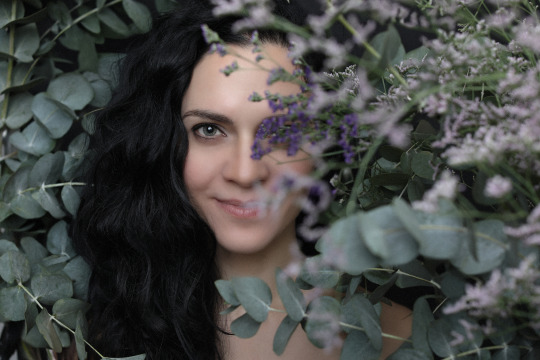
[La violinista hispanofrancesa Leonor de Lera / RAQUEL PASCUAL]
La violinista Leonor de Lera publica un álbum con disminuciones propias sobre repertorio vocal de principios del Seicento
Especialista absoluta en el repertorio para violín del siglo XVII, Leonor de Lera publica su primer disco sin su grupo, L’Estro d’Orfeo.
–¿Por qué este nuevo formato?
–Sentía que en este momento de mi carrera necesitaba hacer algo fuera de mi grupo. No es que haya pasado nada con él ni que piense dejarlo, pero creí que era el momento de hacer algo así, como Leonor de Lera, con todo el peso sobre mí. Obviamente no puedo tocar este repertorio yo sola como si fueran las Sonatas de Bach, tengo a gente que me acompaña. A Nacho Laguna lo conocí trabajando en otro grupo, y de Pablo FitzGerald había oído hablar muy bien, fui a verlo cuando vino a tocar aquí..., me gusta mucho cómo tocan los dos. Las cuerdas pulsadas me venían muy bien para el tema de la Arcadia que había elegido, porque los pastores de este entorno siempre acompañaban el canto con laúdes y guitarras. Era una forma de cambiar el acompañamiento al que estaba más acostumbrada con mi grupo y al ser dos me da una variedad para usar diferentes combinaciones.
–Insiste en el Seicento. Su especialización en la música para violín del XVII es absoluta, ¿qué le atrae de esta música?
–Su lenguaje, tan distinto al del XVIII. Tiene un algo en las armonías, en el modo de hacer las melodías. Es el momento en que el instrumento se hace solista y empieza el virtuosismo instrumental. Hay muchísima exploración, a ver dónde puedo llegar con este instrumento… y eso se refleja en la música que escribían. Cuando me puse a estudiar el violín barroco desde el principio tuve una conexión muy fuerte con este estilo de música y por eso quise profundizar en ella. Es la que más feliz me hace. Me parece apasionante, y me encanta cómo suena esta música. Como es un lenguaje tan diferente al que viene más tarde tienes que estudiarlo en profundidad, tienes que leer mucho, poner mucho en práctica, pensar mucho, tocar mucho para poder llegar a expresar una idea clara del estilo… Ya sabemos que son interpretaciones nuestras de hoy en día, porque no tenemos un disco para escuchar cómo tocaban entonces, pero pienso que con el material que tenemos nos podemos acercar bastante. Si uno lo interpreta bien podemos acercarnos mucho a cómo se tocaba en el siglo XVII. No estoy de acuerdo con los que dicen que nos estamos inventando las cosas. No. Tenemos suficiente material como para saber por dónde iban los tiros.

–El repertorio instrumental de esta época es amplio, pero menor del que vendrá después. Así que aquí decide meterse en música vocal…
–En realidad no hago más que lo que hacían ellos en la época. Como esta música no está tan cerrada formalmente, hay mucha libertad para ornamentar, y de ahí viene todo mi interés por la disminución, porque era consustancial a la música del período. En la partitura no está todo escrito, se esperaba que el intérprete añadiera ornamentaciones en las cadencias y en determinados pasajes de las obras, en las repeticiones, como era práctica usual coger obras vocales conocidas y componer nuevas melodías con disminuciones. Todos los tratados de disminuciones tienen ejemplos justamente de eso. A mí me da tantas posibilidades… Me permite ser muy creativa y hacerme medio compositora de esa obra, lo cual es muy gratificante. En mis dos discos con L’Estro d’Orfeo ya hacía disminuciones: en el primero hice sólo una obrita, pero ya en el segundo, que se titula justamente L’arte di diminuire, hice alguna más. Y en este prácticamente todas son mías: 16 de 18. Las otras dos son disminuciones del tiempo: Un Gay bergier de Riccardo Rognoni, que no se ha hecho mucho, y el Vestiva i colli de Francesco Rognoni que sí es bastante habitual. En Vestiva i colli sólo añado una cadencia final a lo Rognoni, hecha en su estilo, para eso estaban en su trabajo las páginas dedicadas a la cadenza final, para añadirlas…
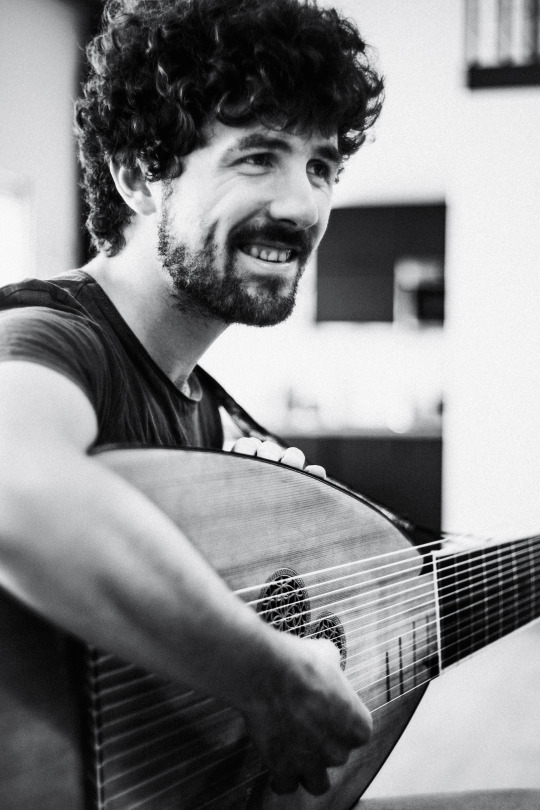
[Nacho Laguna / KEN YOSHIDA]
–Es un CD con temática literaria: la Arcadia.
–Es nuestro decorado. Son textos de los poetas famosos sobre la Arcadia, Sannazaro, Guarini... Textos pastorales, un tema que hizo olas, se hizo muy popular, luego perdió importancia y a finales del Renacimiento volvió a subir mucho. Textos en torno a la Arcadia, historias con dioses, semidioses, pastores, que conviven en un ambiente idílico y casi todos son en torno al amor en sus diferentes posibilidades. Escogí madrigales, canciones y villanescas que me inspiraban mucho, y con ellos hice un programa creo que variado.
–¿La ordenación en el CD tiene algún sentido? ¿Se cuenta una historia?
–No hay un guion de historia. Tenía claro con qué quería empezar. Busco algo de variedad y contrastes, el moverme de afecto a afecto.
–¿Una especialización tan marcada es una ventaja o un hándicap para salir al mercado de los conciertos?
–Cuando empecé pensé justo en si no me estaba cerrando muchas puertas, pero hablando con mis compañeros que tienen grupos para hacer música antigua posterior tampoco es que estén trabajando el doble o el triple que yo. Además es lo que más me gusta… No me apetece montar un grupo, con todo lo que eso lleva, para hacer algo que hace todo el mundo o que no me apasiona. Yo voy a seguir con esto, aunque sea difícil, hasta donde pueda. Es cierto que España no es el mejor sitio para presentar este tipo de repertorio instrumental, porque los programadores no lo conocen mucho y actualmente se orientan sobre todo en recuperación de repertorio español o música con cantantes, porque parece que solo la música vocal con un cantante famoso es lo que vende. Es difícil salir de ahí, lo que me parece erróneo, pero ya sabemos cómo es el mundo… Obviamente hay que vivir, pero mientras pueda yo voy a seguir por este camino, haciendo lo que estoy haciendo.
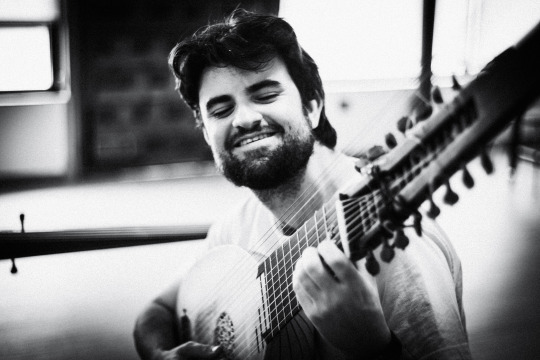
[Pablo FitzGerald / KEN YOSHIDA]
–¿Cómo llega a Pan Classics?
–Los dos primeros discos estaban en Challenge, pero quería cambiar. Contacté con varias discográficas y escogí a Pan Classics, porque me ofrecía las mejores condiciones de acuerdo a lo que yo quería hacer.
–¿Espera más trabajo con la publicación de este disco?
–No lo sé. Espero que dé sus frutos… Pero aunque a mí no me salieran más conciertos, me hace mucha ilusión que la gente lo escuche, porque es mi proyecto más personal, ya que la mayor parte de la música la he escrito yo…
youtube
–¿Hay ideas para próximos proyectos?
–Tengo como cien ideas para discos. Lo que no tengo es dinero…
–¿Y la música algo posterior, la de los Pandolfi Mealli, Uccellini, Schmelzer, Biber…?
–Pandolfi lo he hecho en concierto ya muchas veces. Este verano estaré en el Alcázar de Sevilla tocando Uccellini y Biber junto a Nacho Laguna. Haré Sonatas del 81, que me encantan, incluso más que las del Rosario, y que toqué mucho cuando estudiaba.
[Diario de Sevilla. 12-05-2024]
ARCADIA EN SPOTIFY
#leonor de lera#nacho laguna#pablo fitzgerald#pan classics#Giammatteo Assola#Giuseppino del Biado#Giaches de Wert#Andrea Falconieri#Claudio Monteverdi#Francesco y Riccardo Rognoni#Philippe Verdelot#Giulio Caccini#Bartolomeo Tromboncino#Vincenzo Ruffo#adrian willaert#sigismondo d'india#música#music#Youtube
0 notes
Text
rb to have an ultra gay 2024
#2024#lgbt#gay#bisexual#bi#lgbtqia#lesbian#transgender#trans#asexual#queer#intersex#pansexual#pan#pride#txt#txt post#text#text post#it’s time to bring back my classic post#3rd year in a row let’s make this another hit!#bring on the holiday cheer and everything queer#wishing you all a gay 2024#every year I get gayer and more queer and every year I’m happier finding my truest self
14K notes
·
View notes
Text
Guillermo del Toro on AI
#Guillermo del Toro#Crimson Peak#Nightmare Alley#The Strain#The Shape of Water#Hellboy#Pacific Rim#Pan´s Labyrinth#The Devil´s Backbone#Mimic#Cronos#horror#horror films#classic horror#sci-fi#sci-fi movies#fantasy movies#fantasy films#fantasy#gothic horror#goth#goths#goth movies#goth films#gothic#del Toro#vampires#goth aesthetic#AI#artificial intelligence
4K notes
·
View notes
Text
Hi

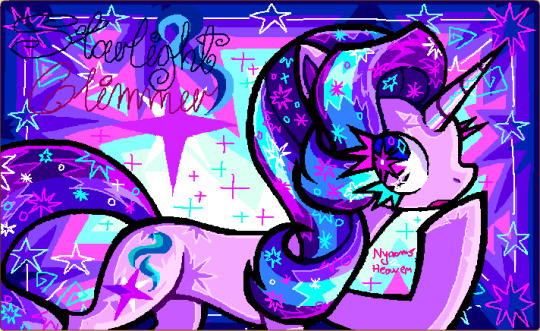
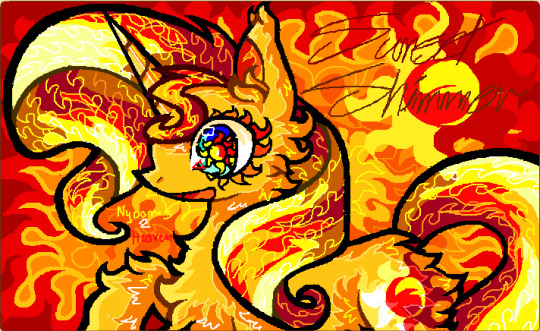
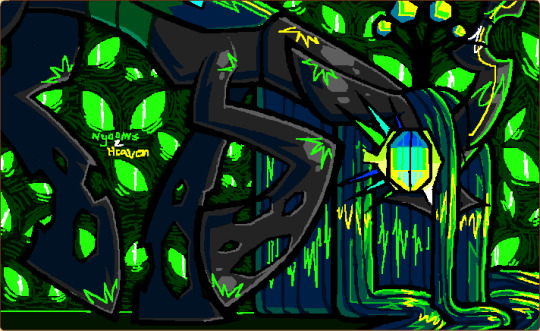


more animal jam mlp masterpieces, probably last ones for now. theyre for sale right now if u wanna buy them hihihi - twirls hair - my username is nyooms2heaven. buy them NOW
#animal jam masterpiece#animal jam#animal jam classic#ajc#my little pony#mlp fim#mlpfim#friendship is magic#trixie lulamoon#trixie mlp#starlight glimmer#sunset shimmer#queen chrysalis#chrysalis mlp#nightmare moon#princess luna#discord#discord mlp#rainbowcore#god i slacked off so bad i had them planned for a month already#someone requested in asks to draw chrysalis. pan każe sługa musi.#but fr pls just commission me next time :pleading face:
954 notes
·
View notes
Text

Hook
Art by Corey Brickley
246 notes
·
View notes
Text


Guitarist John Sykes... Rest In Peace
July 29, 1959 - January 20, 2025
#john sykes#rest in peace#january 20#whitesnake#thin lizzy#tygers of pan tang#blue murder#hard rock#heavy metal#classic rock#classic metal#hair metal#80s music#80s rock
178 notes
·
View notes
Text
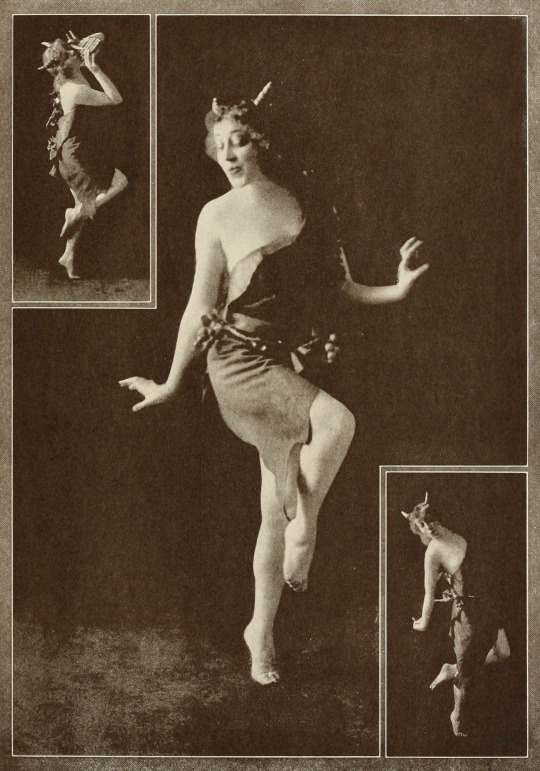
Helen Moller - Adaptation of the Classic Idea of Pan
from 'Dancing with Helen Moller', 1918
#helen moller#adaptation of classic idea of pan#dancing with helen moller#1918#1910s#greek mythology#dancer#photography
227 notes
·
View notes
Text
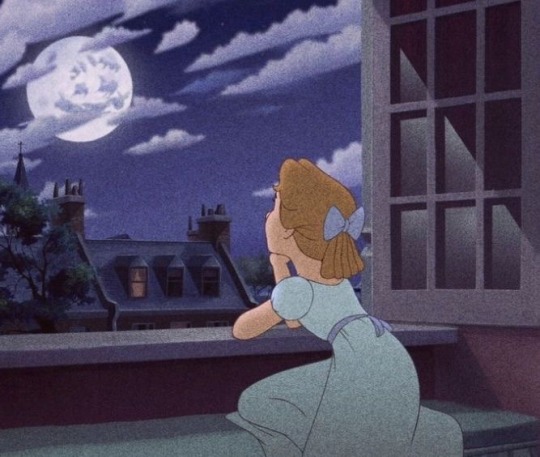
Me every night looking at the moon💕✨
#wendy darling#Peter pan#Disney#Disney movie#disney classics#Wendy#peter and wendy#never land#champagnexowishes#love#girly#pretty#vintage#movie stills#princess#cute#moon#meme
441 notes
·
View notes
Text



NBC broadcasted a live production of the Broadway musical "Peter Pan," starring Mary Martin, on March 7, 1955, as part of the "Producers' Showcase" anthology series. A record 65 million viewers tuned in.
74 notes
·
View notes
Text
PROOF THAT HOOK X CRUELLA X JAFAR ARE CANON:
(this is a joke don’t take it too seriously)

ofc they sit next to each other



healthy relationship goals




yes sing, SINGGG

hahaha silly hand

yeah okay casually flirt with each other


teehee laugh
yeah also the Simpsons helped us‼️

me when the zaza hits hard
#fandom#cartoon#villain#disney villains#captain hook x jafar x cruella#disney jafar#jafar x hook x cruella#cruella de vil#captain hook#536192#Idk I saw that on a tag#disney#disney classics#polyamourous#polyamory#poly ship#poly shenanigans#fandom ships#ships#ship#shipping#Simpsons#aladdin#101 dalmatians#peter pan#crossover#villain x villain x villain⁉️#fandom stuff#photoset
132 notes
·
View notes
Text
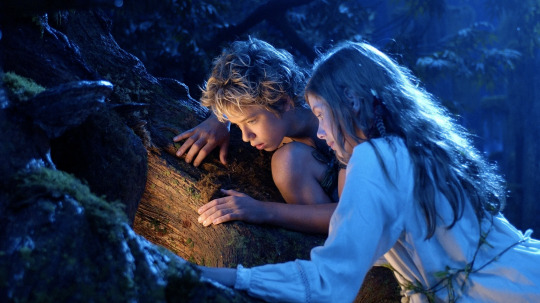
P.J.Hogan's 'Peter Pan' is still an underrated masterpiece 20 years later
Peter Pan is a live-action fantasy adventure film directed by P. J. Hogan that reimagines the classic story of Peter and Wendy. The screenplay was written by P. J. Hogan and Michael Goldenberg and was released in cinemas in December 2003. The screenplay is based on the 1904 play Peter Pan, or The Boy Who Wouldn’t Grow Upand the classic novel Peter Pan by J.M.Barrie, which was originally published under the title Peter and Wendy.
The film tells the story of a young Edwardian girl, Wendy Darling (Rachel Hurd-Wood) and her two younger brothers John and Michael. On the night she is told she must grow up, a wild, fairy-like boy called Peter Pan (Jeremy Sumpter) flies into her room with his high-maintenance fairy Tinkerbell. When he learns that she tells stories, he whisks Wendy and her two brothers away to a magical Island called Neverland — where you supposedly don’t “grow up” — so that she can mother his henchmen, the Lost Boys. There she fights pirates led by the evil Captain Hook (Jason Isaacs), meets mermaids, dances with fairies, falls in love and grows up.

I have strong family connections tied to Peter and Wendy and J.M.Barrie. My great, great uncle Nico was one of the sons of Sylvia Llewelyn Davies'. He and his other brothers "the Lost Boys" were adopted by J.M.Barrie; which ultimately inspired him to write Peter Pan. Nico’s daughter Laura — my cousin — who I met for the first time a few years ago, told me that she was flown to Australia for the filming of P.J. Hogan’s Peter Pan because she was J.M.Barrie’s goddaughter. She told me that she was thrilled with the cast, especially Jason Isaacs, who played Captain Hook and Mr Darling. She also mentioned that Jeremy Sumpter, who played Peter Pan, was a lovely boy. However, she said she was very surprised and sad that the film wasn’t a big success as she really liked what they did with the story. I have loved the fairytale of Peter Pan from a young age, and learning that I am literally part of the family that inspired the story was very exciting and I’ve only begun to internalise it more as I’ve grown older.
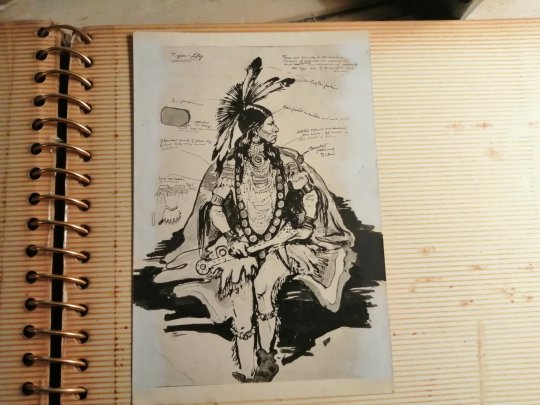
When I was in my mid-twenties, I was diagnosed with a high level of Autism. One of my main symptoms was labelled “ageless”, which in simple terms means that one half of me is still a child that I can’t mentally leave behind. I can’t do many things that most adults can do, such as pay bills, drive a car, look after my own well being etc. I flap my hands when I get excited. I bounce. I sometimes speak in a baby voice. I overcommit to things I enjoy. I admit that it was hard to come to terms with the diagnosis when I first received it. But over time, I’ve come to believe that the two can coexist in a healthy way. I believe that I am an adult who is able to develop and grow while still carrying the child within me, and that this is not seen as a bad thing. I think Peter and Wendy can be seen as a reflection of that.

I was first introduced to P.J. Hogan’s Peter Pan a few years after it was released (I was maybe nine or ten years old), and I absolutely loved it. It wasn’t only one of my favourite film adaptations, but one of my favourite movies of all time. What surprised me most about the film at that age was how dark and gruesome it was, and full of this underlying sexual tension that I hadn’t expected at all from Peter Pan. Even today, this film still has a special place in my heart. It is made with so much passion and love for the original text that I can automatically put myself back into the story. After watching the film again as an adult, I almost immediately opened my copy of Peter and Wendy and started reading. I would even go so far as to say that I prefer the film to the book. However, part of me wishes that the age rating had been set much higher, as the dark and gruesome moments were some of the strongest parts of the film adaptation. This is possibly why some critics and viewers had difficulty categorising the film at the time.
However, I often consider P.J.Hogan’s Peter Pan to be the same equivalent as Joe Wright’s Pride and Prejudice. (which came out a few years later in 2005, starring Keira Knightley and Matthew Macfadyen). The film moves at the same dreamlike pace. It is light, dark, colourful and deeply romantic.

I also often prefer P.J.Hogan’s Peter Pan to the 1953 Disney Animation of the same name, even though it’s the version I grew up with and liked. I find it much less straightforward and innocent. Also, the 2003 film is much closer to the original source material, which I loved reading as a teenager, and to J.M.Barrie’s original vision. The film manages to reflect the same intellectual subtext and depth of the novel while retaining the whimsy and magic.
Magical Realism

Peter Pan was a perfect blend of fantasy and realism. A lot of media these days focus too much on “realism” and make their sets and CGI look bland and washed out. It’s a common myth these days that no one likes whimsy anymore; it’s somehow seen as too childish. As a result, much of the magic of fantasy is lost. But in this Peter Pan, a lot of colour was used in the set design and cinematography. Everything was so brightly and colourfully lit. Most fantasy films these days, including the new live-action adaptation of Peter Pan and Wendy on Disney+, are all so gloomy and dark. You almost have to light up the screen to make out the actors’ facial expressions or what’s happening in the scene. But this film understands that a viewer who watches fantasy wants to be swept away, but also wants a certain amount of believability. Although the film contained a good amount of darkness, it did not shy away from being cartoonish either (which I think was partly inspired by the Disney animation), i.e. characters blushing or bouncing on the clouds.
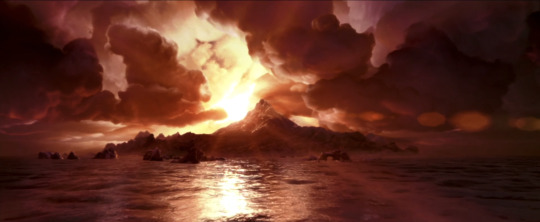
The design of Neverland was breathtaking. I think the CGI, although criticised by some, made the island and creatures look more dreamy and fairytale-like. It was a good combination of CGI for the landscapes and real backdrops for the jungle, so there was enough magic and believability to transport the viewer into the story. A bright colour palette was used for the landscapes, while down-to-earth colours such as browns and greens were used on the ground, such as in “The Lost Boys Hide” under the tree, to give a sense of realism. The costume department also reflected this, from the majestic reds and blacks of the pirates, to the earthly colours of blue and red for the Native Americans, to the natural greens and browns of the Lost boys. I noticed that the colours in Neverland were used as a contrast to the Edwardian London back home, which is realistic but dull compared to the island.
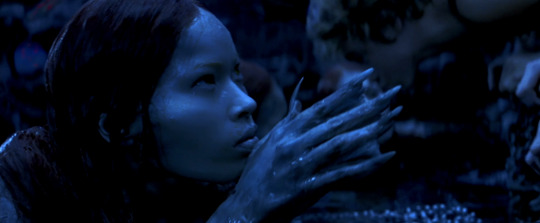
One aspect I liked was that the lighting on Neverland always changed depending on the mood of the scene- unlike the naturalistic lighting on Earth. It was almost as if the island was a living being. For example, when there was a fight on the ship, the lighting was red. When Peter took Wendy to the mermaids, who were scary and frightening, the lighting was dark and blue. This created a surrealistic atmosphere, almost like a fever dream or a kind of nightmare.
Sometimes the environment changed depending on Peter Pan’s mood in the respective scene. I particularly liked how Peter Pan influenced the weather on Neverland. Just his mere presence when he flew to the island changed the entire atmosphere in an instant. His feelings also determined whether it was summer or winter. In other words, its suggested in the film that the longer he has been there, the more the island has become a part of him, so that he can no longer leave it. It’s almost as if the island has transformed him into a magical being.

The exuberant musical score by James Newton Howard: I’ll never forget that. I think that was one of the first movies I saw where I actively noticed the music because it was so brilliant. Even today, the “Flying” soundtrack still gives me goosebumps. It perfectly encapsulates the whimsy, joy and imagination of Peter and Wendy. I loved that there were always different variations. One of my favourite pieces from the movie is ‘Fairy Dance’, which starts off cheerfully and moves up and down depending on the characters’ conflict/what they’re saying in the scene.
Cast
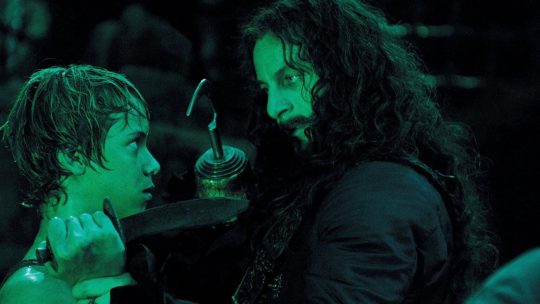
The cast of this film adaptation was magnificent. The look of all the actors not only matched the book description, but also the mood, especially with the Darling family. One of the standouts was Olivia Williams as Mrs Darling. She captured the gentleness of the character perfectly. I also loved the new addition of Aunt Millicent, played by Lynn Redgrave. She fitted into the story so well that I was surprised not to find her in the novel. She had the perfect amount of ridiculousness and hilarity that suited J.M.Barrie’s style.
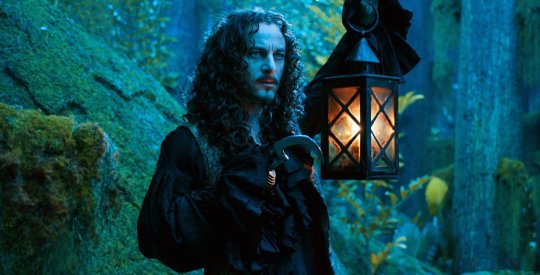
One particular member of the cast we can probably all agree on that was perfect, was Jason Isaacs, who played both Wendy’s father Mr Darling and Captain Hook. He was certainly a star in this film for sure. I just can not think of anyone who could play him better, especially in a live-action film adaptation. He was particularly good in the role of Captain Hook. When I first saw the film as a child, I did not know that Captain Hook and Mr Darling were played by the same person until my dad pointed it out to me because he was so good. I loved how they portrayed Wendy’s dad as shy and reserved, as opposed to Captain Hook who was flamboyant and sinister. Mirror versions of each other in different realities — that’s a common theme throughout the film. As Captain Hook, Jason Isaacs perfectly captured the essence of viciousness, deviousness and brutality that was necessary for the character. But also the deep loneliness and frustration behind it all. I have seen a quote that was supposedly cut from the film (and never should have been) that provides so much context for his hatred of Peter Pan:
“Imagine a lion in a cage and into that cage flies a butterfly. If the lion was free, it would pay no heed to such creature. But the lion is not free…and so the butterfly drives him slowly insane.” — Captain Hook
They did a really good job of showing how Peter Pan and Captain Hook are mirror images of each other. Peter Pan is a child who secretly wants to be an adult, while Captain Hook is an adult who secretly wants to be a child. Both fight each other for different reasons, but the goal is the same. For example, there is a great scene towards the end where Captain Hook uses his wits to defeat Peter in a fight. Here it becomes clear that there is deep symbolism for the inevitability of adulthood and the loss of childhood. Jason Isaacs really showed off his acting talent here. I liked that he wasn’t portrayed as a “dumb villain”, which he easily could have been.
There were also some great performances among the adults. Most notable was Richard Briers as the ‘pirate’’ Smee. But the child actors, especially the lost boys, really held the movie together. Their solid performances made it so believable that the island was ruled by children. I loved Theodore Chester as Slightly. He was very charming and funny in that role.
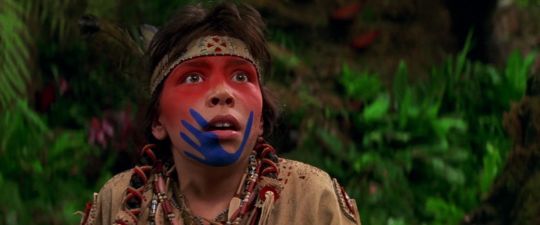
Another member of the cast I thought was brilliant was Carsen Grey, an indigenous actress of Haida descent, who played Princess Tiger Lily. I liked that they let her speak her ancestral language, Mohican, in this film. Although this film came out in the early 2000s, it is the only version of Peter and Wendy in which Native Americans are neither erased nor white-washed even though the representation is far from great. Considering how they’re treated in the novel, it’s perhaps for the best overall that they limited some of their scenes. However, I liked how firey she was in this adaptation and not the damsel in distress she was portrayed as in the Disney animation. I think it was a wise decision to cut the infatuation she had with Peter Pan, as it was really just one line in the book that would have added unnecessary drama, and all in all, it would have fallen short if all the female characters were jealous of each other.
They also downplayed Tinkerbell’s jealousy in this regard, portraying it more as her trying to protect Peter Pan’s youth from romantic advances, as hinted at in the novel, and also being sad that Wendy is attracting all of Peter Pan’s attention. Ludivine Sagnier has, in my opinion, succeeded well in making Tinkerbell equally repulsive and endearing, as befits the character.
Wendy Darling
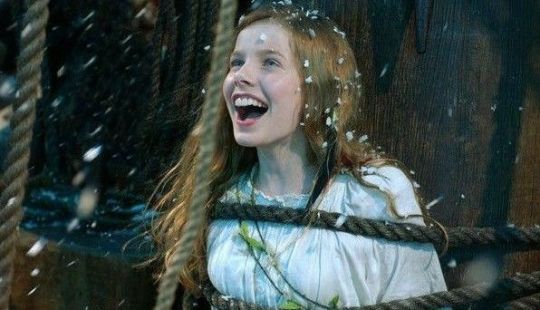
Rachel Hurd-Wood was the perfect cast for the role of Wendy Darling.I was actually surprised to learn that this was her first film role ever, because she was a natural. She effortlessly possessed the same caring nature and charm that makes Wendy so endearing. She is exactly how I imagine the character when I read the story. When people talk about Peter and Wendy, they always mention Tinkerbell, Pan or Hook, but personally I am always drawn to Wendy. She is the real heroine of the story. After all, she was the main reason for Peter to bring her and her brothers to Neverland.
What always amazes me about Wendy’s role in the story is the fact that Wendy literally doesn’t spend much time being a “child” in the time she spends in Neverland. When she’s not escaping death at the hands of mermaids or pirates, she acts as a mother to the ‘lost boys’ and her brothers. She asks herself what she really wants from life. In comparison, she was allowed to behave more like a child at home in Edwardian London. Neverland is not a place where you never grow up. It’s the place where she chooses to grow up. Many people have described Neverland as a manifestation of Wendy’s subconscious as a result of trauma, and I’ve never found that to be more true in this adaptation.
One of the reasons why I think P.J. Hogan’s Peter Pan is the best adaptation of the novel is the fact that the film revolves around Wendy’s coming of age. I loved that they expanded on her love of storytelling and also gave her a tomboyish streak. Instead of just being on the sidelines, she’s able to get involved and fight pirates while retaining many of her feminine traits such as her maternal instincts and romantic feelings for Peter. She makes mistakes and sometimes gets dragged into things she knows she shouldn’t do. But in the end, she triumphs.

In many film adaptations of Peter and Wendy that I have seen, Wendy is either only present in passing or not at all. Characters like Peter Pan, Captain Hook and Tinkerbell always take centre stage, which I think is a strange decision as they are part of Wendy’s story and not the other way around. Peter Pan is meant to metaphorically represent the childhood she does not want to give up (which is why the character is always played by a woman in the original play, as he is a mirror image of Wendy). And Captain Hook (J.M.Barrie also wanted him to be played by the same actor as Mr Darling) represents the dark side of her father, or rather what she imagines adulthood to be. This is particularly emphasised in this film adaptation because he is an important factor in her being told to grow up. The father, the concept of adulthood, and Peter Pan, her childhood, are at constant war with each other.
“You’re not supposed to be like Peter, who kept every good and bad aspect of being a child and can’t tell right from wrong. You’re not supposed to be Hook, either. He let go of everything childish and loving about him and became bitter and evil..You’re supposed to fall in the middle, to hold onto the things about childhood that make it beautiful — the wonder, the imagination, the innocence — while still growing up and learning morality and responsibility. You’re not supposed to be Hook. You’re not supposed to be Peter Pan. You’re supposed to be Wendy Darling.” — @maybe-this-time
The 2023 film Peter Pan and Wendy took a different approach, by making Wendy a kind of powerhouse who always saved the day and outshone Peter Pan overall. In my opinion, the 2003 film adaptation emphasised very well that Wendy really is the yin and yang. She's allowed to be romantic, be rescued by others and at the same time determine her own destiny and stand up for herself. Because that’s what her journey in the adaptation is all about. She is pressured by all the adults in her life to grow up. She allows herself to be seduced with the prospect of an eternal childhood by Peter Pan. Then she realises that it is not self-fulfilling. She is tempted by Captain Hook with the concept of adulthood. And finally, she finds a balance between these two extremes on her own terms. By the end of the film, Wendy has made her peace with growing up while still remaining a child at heart. That requires a certain mental strength that we should all strive for.
Peter Pan and Wendy Darling
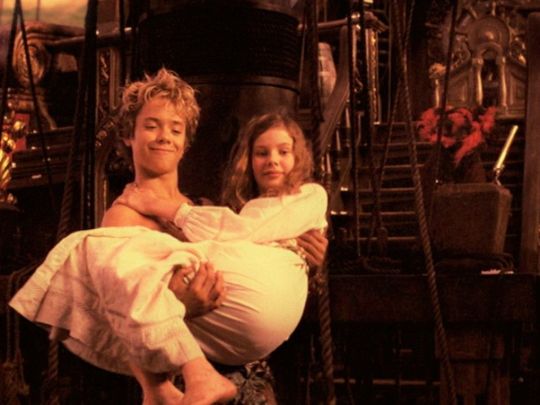
In most adaptations of Peter and Wendy, such as Hook and Syfy’s Neverland, the focus is on the title character Peter. In the more recent film adaptation Peter Pan and Wendy, the focus is on Wendy. This film adaptation of Peter and Wendy, on the other hand, sticks more closely to the original source material, as the story focuses on Peter and Wendy’s relationship. This is perhaps the reason why I always hesitate when I watch other adaptations, because these two characters are supposed to go together. It’s definitely a relationship that can be portrayed in all sorts of ways because they are symbolically the same person.
Although there is no romance between Peter and Wendy in either the original novel or the play, Wendy quickly develops romantic feelings for Peter which, as a prepubescent child, he does not consciously reciprocate as he has no concept of love other than that of a mother’s. Although Peter cares deeply for her, he ultimately only longs for her to be the maternal figure that is missing in his life. One could go into the symbolism that Peter and Wendy are one and the same, and that this is an expression of Wendy learning to love herself. But in a literal sense, J.M.Barrie had unintentionally created this very strong potential between the two characters. And I personally feel if your'e going to make an adaptation of Peter and Wendy that potential needs to be explored in some way, even if it’s not necessarily romantic.
Hogan recognised this potential and developed the romantic elements, e.g. ‘the “thimble” from the novel, into a very real and tangible plot. In other adaptations, Peter and Wendy’s relationship is rather one-sided. But in P.J. Hogan’s film adaptation, however, it is not at all. Over the course of the film, Peter and Wendy fall deeply in love with each other.

Rachel Hurd-Wood and Jeremy Sumpter had a remarkable on-screen chemistry for young actors, which helped give the adaptation its own identity. Whenever they interacted on screen as Peter and Wendy, it was — like the glittering pixie dust of Tinkerbell — simply magical. The off-screen chemistry between the two definitely helped make the romance so believable as well. When I was younger, I didn’t like romantic subplots in family films. I personally found that they clogged up the main plot because the “romance” tended to be very one-dimensional- but Peter and Wendy in the 2003 film version were simply enchanting.
In the original novel, J.M.Barrie alludes to the possibility of a romance between the two. In the film adaptation, they go all out. Their love story was written so beautifully and profoundly, while staying true to the original text and J.M.Barrie’s themes. This made the conflict hinted at in the novel of “staying in Neverland with Peter or growing up on Earth with Wendy” even more poignant and relevant, because in reality there was only ever one option. They couldn’t find a way to have both. That made the ending even more ���heartbreaking” for me as a child, because even though they had the chance to be happy together, she couldn’t give up on growing up to stay. And he couldn’t give up being a child to leave, even though it was a natural progression for him.
Peter Pan
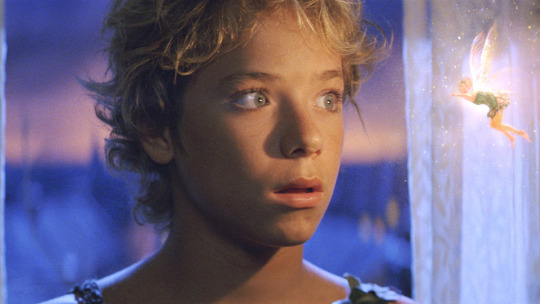
Jeremy Sumpter delivered a fantastic performance as Peter Pan. Not only did he perfectly match the illustrations, but he also managed to perfectly capture the essence of the charismatic, mischievous little boy from the novel. What’s more, of all the versions I have seen so far, he is by far the most accurate, right down to the clothes made of skeleton leaves, the dirty fingernails, the feral mannerisms, the traumatised soul behind the charm and the downright creepy insinuations. By today’s standards, you could almost take Peter Pan for a grown man who consciously decides not to behave like this.
However, when I watch the film again as an adult, I can now understand why he has reservations about growing up in Edwardian England and would rather remain a “child” in Neverland forever. As Peter says in the film, “Would they send me to school? And then to an office?” I feel like most of us today have so many choices as we get older, but back then it was much more limited. The choices were very restricted in that “heterosexist” environment. You could only be a certain thing, and it was much harder to hold on to the pleasures of life. I can now also understand the initial reactions of Michael and John to Peter: He must have seemed scandalous to people at the time. His bright colours, his inappropriate clothing and his behaviour are repulsive to the boys, but Wendy is immediately fascinated and attracted. I think it was a deliberate choice that he is the only character with an American accent to set him apart from the rest of the cast; to emphasise the wildness of the character and his non-conformity to the people of Edwardian London.
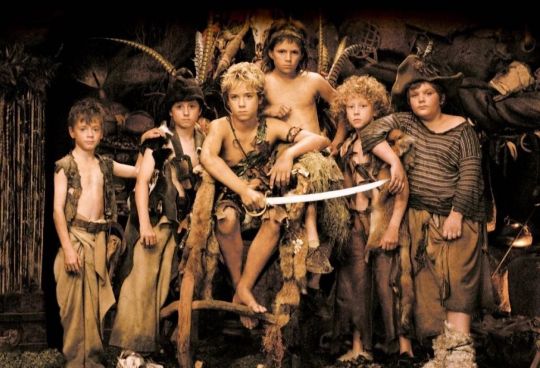
Another small aspect I liked was the suggestion that the Lost Boys, although they lived with Peter and obeyed his commands, lived in constant fear of him and did not worship him as in other adaptations. (A fear that is justified as Peter tries to kill them more than once in the film). What the 2003 film adaptation captured perfectly about Peter's character was: how terrible of a person he really is. Peter Pan is a hero when he goes on adventures and fights pirates. You could argue — via the quote “Leave Hook to me” (which Peter says to her in the film) — that Peter is Wendy’s split self who can fight her father (Captain Hook) for her, just like antibodies do with germs when we can’t handle them ourselves.
However, when it comes to understanding emotions, caring about others, even his henchmen, the Lost Boys, and doing anything that inconveniences him, Peter Pan is possibly as bad as Captain Hook. This makes Wendy’s decision to leave him all the more powerful. Although she was initially seduced by his adventurous life, she soon realises that his “life” of joy and adventure is not fulfilling at all. Because in reality, there is no real joy. There is no real adventure. In reality, his life is empty because it is not earned. In addition, she realises that she is gradually losing her memory of the outside world, including her parents - a sign that she is “slowly awakening from the dream”. This leads Wendy to realise that she wants more than what he can give her in Neverland (e.g. romantic love) and decides to leave. Being alive means feeling, accepting and growing. However, as long as Peter remains a boy, he can never truly be alive. Peter Pan conveyed this important message, whereas earlier film adaptations, including the Disney animation, did not.
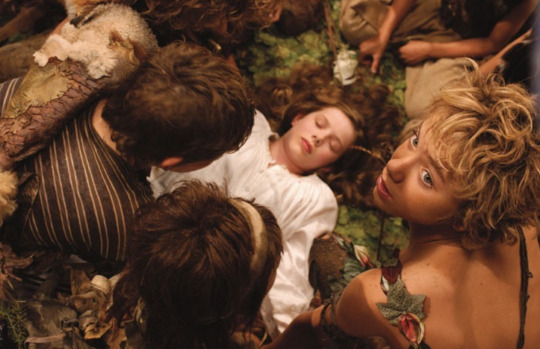
One of the reasons why good adaptations of Peter and Wendy are so hard to come by, especially in this day and age, is not only because they adapt a performative story that exists in layers of subtext. They also work with a protagonist who doesn’t change. Who doesn’t develop in any way, neither negatively nor positively. Not even just physically, but also mentally. (Even Eli from Let the Right One In, the child vampire, changes in the course of the story). At the end of day, Peter Pan is ultimately there to serve someone else’s story. It works in a fairy tale format. But it doesn’t usually translate very well to the screen because it often leads to one-dimensional storytelling. Even if it seems so natural, it doesn’t come naturally.
However, this adaptation allows Peter Pan to grow. The writers expanded on the small aspect from the book, which is the moment when Wendy enters Peter’s life; he begins to feel emotions. Not just love. But anger. Fear. Sadness. Pain. Disgust. And above all: self-awareness. Almost like a version of puberty in condensed time, as if the change suddenly caught up with his body. When Wendy brings this up, Peter immediately rejects it out of fear. I think most of us can all relate to this when we were in the midst of growing into a young adult. We experience feelings that are scary and new, that we can’t yet fully understand or even want to. For Peter Pan, falling in love is exactly what he is afraid of: growing up and no longer being a child. This adds to an interesting conflict that arises between the two when she asks him to leave with her.
“The thing about Peter Pan is, he’s a coward. Had the chance of a lifetime and he bottled it. Just fucked off back to Neverland. All alone, forever he was, by his own hand. Poor old Wendy, she had to grow old without him.” — Skins, 6x07 “Alo”
In the original novel, the reason Wendy can’t take Peter Pan with her (apart from the fact that he refuses to grow up) is the same reason Lyra in His Dark Materials can’t take Pan — the animal manifestation of her soul — on the boat to the land of the dead. She has to split in order to grow up and leave a part of herself behind. She can’t keep both in order to move on. But that does not mean I always agree with the ending either. In which Peter remains a child and takes Wendy’s future descendants to Neverland and back to look after him. It leaves an icky aftertaste, but at least it fits in with the story J.M. Barrie wanted to tell.

Even though the adaptation conveys the same message, that Peter Pan is the manifestation of Wendy’s youth, even to the end. In this version of Peter Pan, that is no longer the case. By the end of the film, the way he holds himself is different. The way he looks wistfully through the open window and solemnly says, “To live would be an awfully big adventure,” : a sign of self-awareness, while Wendy happily reunites with her family. So much so that Tinkerbell has to pull him by the hair to stop him from joining them and reconsidering his decision. Peter is now old enough to know that he loves Wendy. Maybe he’s also mature enough to know what he’s missing, but he knows he can’t have her the way he wants, so he does the most selfless thing he’s ever done in the whole film by letting her go.
There is no such conflict at the end of the 1953 Disney animated film. Peter Pan is described by Wendy as “wonderful”. In reality, everyone else gets their happy ending, except him, because he deliberately chooses not to. Peter Pan very much turns himself into a tragic figure because he is afraid of the most natural thing in the world. He is afraid of life. And I feel like this version of the story knew that and expressed it strongly, which makes me conflicted now as an adult. I’ve seen endings like this before, where two people fall in love but do not end up together because they grow apart or they are both interested in different things, and it’s very important to reach those points in different ways. It very much reflects real life and is also reminiscent of first love. How that love never really fades. It reminds you of simple times, even when you’ve grown up and moved on. That a part of you is still at that age when you look back on it. These endings happen because people grow — which Peter Pan does not.
“Peter in the books lives in oblivious tragedy. He may suspect that he’s not fully happy, but he tends to forget about it… yet this Peter doesn’t… Wendy leaving him and growing up to be a wife of another man is his unhappy thought…It’s the loss of innocence since Peter could not forget this…It’s the process of growing up…all but confirms that Peter’s character arc in the film is one of accepting the fact he too must grow up to be happy.” — @rex-shadao
And I think that’s the real reason why his character is both the strongest and the weakest part of the adaptation. The writers didn’t make it clear enough that Peter Pan forgets in their version of the character. In the novel, Peter Pan forgets everything automatically, which is why he can exist in this limbo of childhood and not go mad. However, as mentioned earlier, this version of Peter Pan is old enough to remember and, more importantly, to feel. Even though he is the closest to J.M. Barrie’s original vision, unlike his counterpart in the book, he is capable of evolving. That’s why the ending sometimes feels strange to me as an adult.
It was hard to say why I had a strange feeling at first, but I realised that a lot of my mixed feelings stemmed from having seen the film adaptation fresh after reading the novel. Since Peter Pan fully reciprocates Wendy’s love in this version, he ends up being a different character than in the book, which is why I now disagree with them keeping the original ending instead of having him grow up with Wendy. It would symbolise that childhood can co-exist with adulthood, that you don’t have to leave a part of yourself behind. That you can be your true and complete self if you find the balance between the two extremes.
The original ending still works however, in all its bittersweetness. I know what it means and understand what it stands for. Wendy basically says goodbye to her childhood and promises never to forget it. There’s a reason it made such an impression on me when I was younger. It could just be because I’m trying to pick up all the pieces of my broken heart from the floor. But personally, as an adult, I just find it weaker compared to the novel. Sometimes I like to imagine an ending to this version of the story where Peter Pan comes back, having quickly realised that he has outgrown Neverland, but doesn’t meet Wendy again until they are both much older, at a time when Wendy is coming to terms with womanhood and the idea of marriage. Or she even meets his real earth counterpart (if we were to delve into the psychology of Neverland being Wendy’s dream). And their relationship is subjected to the natural test of time and growth.
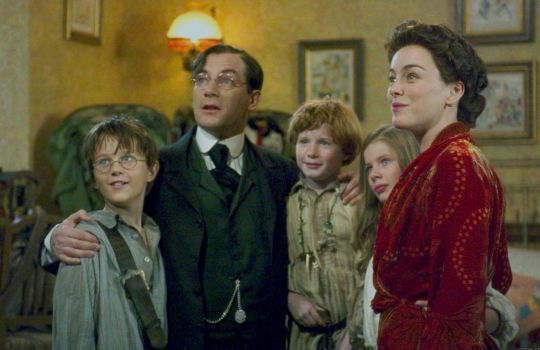
Peter Pan is an almost perfect adaptation. It matches the humour, the tone and the vision of J.M.Barrie. But I can certainly understand why the film didn’t do so well at the box office. In the month it was released, there was an unfair amount of competition, namely the film Lord of the Rings — The Return of the King. And as an adult, I can now understand why it’s not the film people think of or remember when it comes to Peter Pan adaptations. And it’s not just because it doesn’t fit the elfish, jolly trickster persona that Disney has created.
The film adaptation suffers more from what it doesn’t do — such as maintaining a stable tone and consistent editing — than from what it does. It’s one of those films that would have benefited from being much longer. And this is going off a point I've seen someone make in the past, that no Fantasy Film should be under two hours because of all the worldbuilding it has to introduce. That way, the inconsistent tone and some of the rushed parts of the adaptation would be much more balanced. It feels like it was missing an extra twenty minutes. For example, the film is narrated by an older version of Wendy, but without the deleted ending where it becomes properly clear that it’s her telling the story to tie everything together, the ending feels a little abrupt. Say what you will about Tim Burton’s adaptation of the Series of Unfortunate Events, but the audience could see where the film’s narration was coming from the whole time. I think if they knew the alternate ending wasn’t going to work (that scene is a classic example of something working well in the novel but not in the film), they should have removed the narrator altogether with the deleted ending and adjusted the film accordingly. They should have extended some scenes so that parts of the film weren’t rushed, such as the introduction, and the story would have been left more up to interpretation as there was no voiceover throughout.
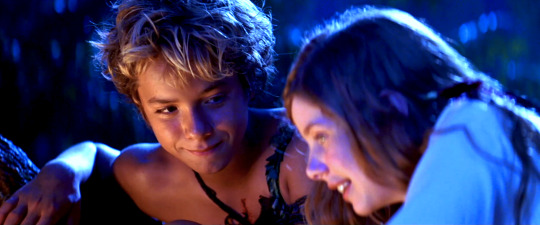
Despite its weaknesses, P.J.Hogan’s Peter Pan is still an underrated masterpiece 20 years later. It is an irresistible film that captivates and warms the heart. The film adaptation has certainly stood the test of time, staying true to the original while adding its own flavour to the story. It is full of magic, wonder and heart. It was clearly made by people who loved the origins of the story and explored where they came from, while also digging deep into the text to reshape the character arcs in a fresh and meaningful way. They succeed in capturing J.M.Barrie’s original message, which is that growing up is a natural progression of life, but that doesn’t mean leaving childhood behind entirely. That it is important to maintain a healthy balance between the two: Taking responsibility while appreciating the joys of life. From the vibrant colour palette to the goosebump-inducing music to the solid performances and gorgeous chemistry between Jeremy Sumpter and Rachel Hurd-Wood, my love for this adaptation will never end, no matter how old I am.
#peter pan#peter pan 2003#jason isaacs#jeremy sumpter#rachel hurd wood#peter and wendy#j.m barrie#peter x wendy#wendy darling#analysis#tinkerbell#captain hook#disney#peter pan and wendy#disney +#hook#James Newton Howard#olivia williams#novel#classic literature#filmmaking#film#cinema#culture#movie review#darling pan#finding neverland#film review#peter pan (2003)#peter pan live action
442 notes
·
View notes
Text
Sammartini, la flauta galante

[La flautista israelí residente en España Tamar Lalo / MICHAL NOVAK]
La flautista israelí radicada en España Tamar Lalo publica en Pan Classics su primer álbum como solista, un paseo por sonatas de Giuseppe Sammartini
Nació en Tel Aviv y buena parte de su formación en música antigua la recibió en La Haya, donde estudió con algunos de los más prestigiosos maestros de flauta dulce (o flauta de pico, como ella y tantos profesionales del instrumento la llaman) del mundo, entre ellos, Peter van Heyghen, Dorothea Winter y Daniel Bruggen, pero vive en España desde hace doce años y aquí se ha hecho un nombre entre los principales grupos barrocos del país, fundamentalmente el conjunto La Ritirata, que fundó y dirige el violonchelista Josetxu Obregón.
–Este es su primer disco como solista después de muchos años grabando con muchos conjuntos, ¿qué cambió?, ¿se sintió ya madura para un proyecto así?
–Llevo muchos años haciendo discos para La Ritirata, no sólo grabar y tocar, sino todo el trabajo de edición y luego de promoción. Y llevo igualmente muchos años dándole vueltas en la cabeza a la idea de hacer un disco dedicado a la flauta, con repertorio elegido por mí, y que fuera cosa mía, pero entre grabación y grabación, pues no encontré el tiempo. El parón de la pandemia me dio la oportunidad de planteármelo definitivamente de forma seria y me lancé.
–A por Giuseppe Sammartini...
–Sí. Me puse a buscar repertorio, a releer mucha música y muchas obras... Giuseppe Sammartini es muy conocido en el mundo de los flautistas por su Concierto para flauta, pero tiene tanta música original para flauta de pico que se conoce tan poco; en concreto, son 32 sonatas para flauta y continuo y algunas para dos flautas. De esas 32 sonatas muy pocas están grabadas y apenas se conocen. Leí toda esta música y me pareció de muy buena calidad y muy variada. Sammartini tenía muchas ideas nuevas. Es un compositor barroco pero con una visión ya galante de la música. Experimenta mucho con las modas, y me pareció que era muy interesante por eso.
–Una de las novedades es formal: todas las sonatas que ha grabado menos una están en tres movimientos…
–Sí, creo que esta forma está en esa línea de mirada al futuro galante de la música, del que le hablaba, pero no sólo ya por la forma, sino por los motivos, las armonías. Tiene muchos elementos galantes e intenté escoger las sonatas en que eso se nota más.

–Sammartini fue un reconocido oboísta. ¿Se nota eso en esta música?
–Nos faltan evidencias de que tocara la flauta. Pero cuando murió dejó a su hermano Giovanni Battista, entre otras cosas, cuatro flautas, no sabemos si de pico o traveseras, aunque probablemente, fueran de los dos tipos. Es la única evidencia que tenemos de que tocase la flauta, pero era lo más habitual de los oboístas en la época. Además escribió tanto para la flauta de pico que nos hace pensar que conocía bien el instrumento. La escritura es muy idiomática, y muestra tanto en las sonatas como en su concierto posibilidades de hacer cosas muy virtuosísticas.
–Sammartini era un compositor del norte, milanés. El repertorio napolitano para flauta de esta época está más difundido y grabado. ¿Su carácter es muy diferente?
–En los últimos años hemos dedicado muchas grabaciones a compositores napolitanos y es distinta. He visitado Nápoles últimamente, y la ciudad tiene algo, hay una atmósfera, que se traspasa a la música, y hasta se puede oler. La de Sammartini es música diferente: nació en Milán de un padre francés que también era músico, pero él viajó mucho, estuvo un tiempo en Bruselas y terminó su vida en Londres. Su música es muy diferente a la napolitana y refleja todas sus experiencias por Europa.
–Ha recurrido a compañeros habituales para un continuo variado...
–Son cinco continuistas, pero en realidad la mayor parte del tiempo me acompaña sólo un teclado (clave u órgano), un laúd y/o un fagot. Sólo en la primera sonata hay cuatro continuistas; el cello sólo toca en una obra y el violone en dos movimientos. Buscaba variedad de sonidos. El fagot va muy bien con esta música. No sé si porque Sammartini era oboísta, pero la escritura de los bajos encaja muy bien con el fagot. El laúd barroco se utiliza poco en el bajo continuo y pensé que esta música fue tocada en Inglaterra, y me pareció interesante, aporta otro tipo de sonoridad.
–¿La parte del bajo continuo es sencilla, un poco en la línea del estilo galante del que me habló?
–No tan sencilla. Depende. Tiene elementos galantes, es simple, limpio, pero armónicamente en algunos momentos nos ha creado dudas, porque Sammartini está experimentando con cosas. A veces es obvio lo que quiere decir y otras no tanto y nos obligó a probar hasta dar con lo que pensábamos que era idóneo. En general es un continuo sencillo, pero con momentos experimentales.

[Un momento de la grabación del álbum / JAIME MASSIEU]
–¿Cómo lleva en concierto las limitaciones en materia de potencia y dinámica de la flauta dulce?
–Depende mucho del instrumento que toque en cada momento, algunos suenan un montón y a otros cuesta un poco más sacarles el sonido. También depende de la escritura de la música y de la acústica en la que toques, pero casi siempre son cosas que se pueden solucionar, es un poco el control del instrumento. Las dinámicas son limitadas, así que hay que buscar opciones de variedad, con articulación, colores, timbres. Cuando te falta algo es la oportunidad de desarrollar otros aspectos, como les pasa a otros instrumentos de la época.
–¿Ha hecho este programa ya en concierto?
–Lo voy a hacer en verano en el Festival Internacional de Santander y en el del Camino de Santiago y después del verano con otros programadores.
–¿Piensa ya en un segundo disco?
–Me ha dejado con muchas ganas. Ideas hay un montón, el problema es encontrar el momento.
–¿Siempre con música barroca? ¿No le interesa la contemporánea que se está escribiendo para instrumentos antiguos?
–Ideas tengo demasiadas, pero hay que decidirse. Hay fantástica música contemporánea para la flauta, sí, y podría ser una opción…
–¿Por qué Pan Classics?
–Grabamos con La Ritirata en Glossa desde hace muchos años y es una marca hermana, ambos sellos tienen el mismo jefe. Cuando le propuse el proyecto me dijo que le interesaba mucho y le pareció que encajaba muy bien en esta marca. Fue un trabajo muy agradable en todo momento.
[Diario de Sevilla. 23-04-23]
EL CD EN SPOTIFY
0 notes
Text
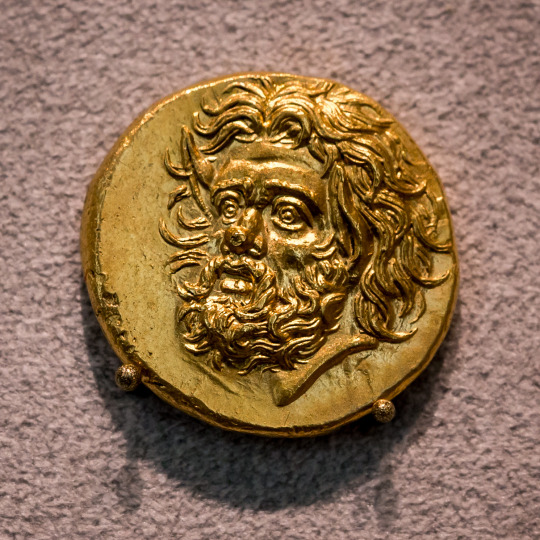
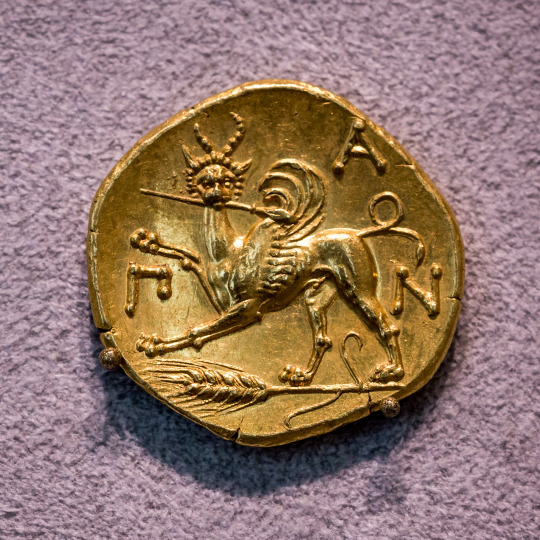
Gold stater (diameter=18 mm; weight=9.09 g) from the ancient Greek city of Panticapaeum, a Milesian colony on the Black Sea. The obverse bears the head of the god Pan, shown in three-quarter view and crowned with ivy. The reverse depicts a griffin with a spear in its mouth, standing on an ear of grain (the Black Sea region was an important center of grain production for the ancient Mediterranean world). Around the griffin are the Greek letters ΠΑΝ. Now in the Münzkabinett der Staatlichen Museen, Altes Museum, Berlin. Photo credits: ArchaiOptix/Wikimedia Commons.
#classics#tagamemnon#Ancient Greece#ancient history#art#art history#Greek art#Ancient Greek art#Panticapaeum#Greek religion#Ancient Greek religion#Hellenic polytheism#God Pan#coins#ancient coins#Greek coins#Ancient Greek coins#stater#numismatics#ancient numismatics#metalwork#goldwork#Altes Museum
416 notes
·
View notes
Text

Käärijätober day 14 “Kids”
#käärijätober#käärijä#häärijä#jeskiedes#pan ochroniarz#fanart#art by op#my art#classic cartoon scenario#phew this was the most ambitious thing i had planned for this promptober now i can do anything#btw jesse will need such a moment of peace and quiet when im done with the fanfic#who said that
109 notes
·
View notes
Text

Luis Egidio Meléndez (Spanish, 1716-1780) Bodegón con plato de ciruelas, brevas y rosca de pan, n.d. Museo Nacional del Prado, Madrid
#Luis Egidio Meléndez#spanish art#spanish#spain#Bodegón con plato de ciruelas#brevas y rosca de pan#art#fine art#european art#classical art#europe#european#fine arts#oil painting#europa#mediterranean#hispanic#latin#1700s#still life#still life art#bodegon#figs#bread
144 notes
·
View notes
Text

#albert camus#classical literature#existentialism#classics#sylvia plath#franz kafka#classical quotes#classical poetry#ancient greek#greek mythology#greek posts#greek tumblr#greek gods#pan deity#madeline miller#the song of achilles#achilles#writers on tumblr#aspiring writer#writers#writers of tumblr#writers and poets#virginia woolf#quotes#poetry#classic literature#book quote#dark acamedia#dark academia
718 notes
·
View notes